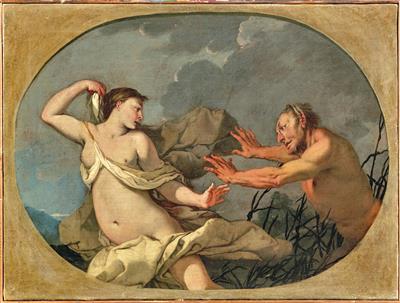Giulio Carpioni, a pair (2)

(Venice 1613–1679 Vicenza)
Pan and Syrinx; and
The rape of Deianira,
oil on oval canvas, laid down on rectangular canvas, each 52 x 68 cm, framed, a pair (2)
Provenance:
collection of Dr. Ivan Boscolo, Padua;
Mario Barbieri collection, Padua;
thence by descent to the present owner
Exhibited:
Venice, Ca’ Pesaro, La pittura del Seicento a Venezia, 27 June - 25 October 1959, no. 135 A/B
Literature:
G. M. Pilo, in: P. Zampetti (ed.), La pittura del Seicento a Venezia, exhibition catalogue, Venice 1959, p. 87, no. 135 A/B, ill.;
G. M. Pilo, Irrequieto Seicento a Venezia, in: Il taccuino delle arti, 1959, p. 2;
M. Valsecchi, Il Seicento a Venezia e a Bologna, in: Arte Club, 1959, p. 17, ill. (Pan and Syrinx);
G. M. Pilo, Giulio Carpioni, Venice 1961, p. 105, figg. 157 and 161 (detail);
R. Pallucchini, La pittura Veneziana del Seicento, Milan 1981, vol. I, p. 215, vol. II, p. 736, fig. 692 (Pan and Syrinx)
The present Pan and Syrinx is registered in the Fototeca Zeri (no. 56892) as Giulio Carpioni. Both paintings were included in the 1959 exhibition held at Ca’ Pesaro, Venice dedicated to seventeenth-century Venetian painting.
The present works are fine examples of the artist’s mature style of the late 1660s to early 1670s, when Carpioni’s painting became increasingly less sculptural, and more graphically refined. The paintings each represent a mythological episode: The Rape of Deianira and Pan and Syrinx and they belong among the painter’s production of profane subjects that are atmospherically reminiscent of Poussin’s Arcadian themes.
Both compositions, of oval format, are illuminated by a clear cool light. The figures are fluid and elongated, with the lithe forms of nymphs and the depiction of the fluttering drapery that appears almost weightless in the air. In contrast to his earlier mythological depictions in which Carpioni focused on the rendering of landscape to project an Arcadian atmosphere on his subjects, the present compositions are simpler in setting and atmosphere, similar to other works of his from this period such as the Bacchanal in the Accademia Carrara, Bergamo.
In Venice, Carpioni was a pupil of Alessandro Varotari, called il Padovanino, who introduced him to the early works of Titian. At the close of the 1630s Carpioni moved permanently to Vicenza where he asserted his ‘barocchismo classicizzante’, his classicising baroque style, (see op. cit. Pallucchini, 1981) with which he distinguished himself from the prevailing baroque taste exemplified, above all, by Francesco Maffei.
23.10.2018 - 18:00
- Odhadní cena:
-
EUR 40.000,- do EUR 60.000,-
Giulio Carpioni, a pair (2)
(Venice 1613–1679 Vicenza)
Pan and Syrinx; and
The rape of Deianira,
oil on oval canvas, laid down on rectangular canvas, each 52 x 68 cm, framed, a pair (2)
Provenance:
collection of Dr. Ivan Boscolo, Padua;
Mario Barbieri collection, Padua;
thence by descent to the present owner
Exhibited:
Venice, Ca’ Pesaro, La pittura del Seicento a Venezia, 27 June - 25 October 1959, no. 135 A/B
Literature:
G. M. Pilo, in: P. Zampetti (ed.), La pittura del Seicento a Venezia, exhibition catalogue, Venice 1959, p. 87, no. 135 A/B, ill.;
G. M. Pilo, Irrequieto Seicento a Venezia, in: Il taccuino delle arti, 1959, p. 2;
M. Valsecchi, Il Seicento a Venezia e a Bologna, in: Arte Club, 1959, p. 17, ill. (Pan and Syrinx);
G. M. Pilo, Giulio Carpioni, Venice 1961, p. 105, figg. 157 and 161 (detail);
R. Pallucchini, La pittura Veneziana del Seicento, Milan 1981, vol. I, p. 215, vol. II, p. 736, fig. 692 (Pan and Syrinx)
The present Pan and Syrinx is registered in the Fototeca Zeri (no. 56892) as Giulio Carpioni. Both paintings were included in the 1959 exhibition held at Ca’ Pesaro, Venice dedicated to seventeenth-century Venetian painting.
The present works are fine examples of the artist’s mature style of the late 1660s to early 1670s, when Carpioni’s painting became increasingly less sculptural, and more graphically refined. The paintings each represent a mythological episode: The Rape of Deianira and Pan and Syrinx and they belong among the painter’s production of profane subjects that are atmospherically reminiscent of Poussin’s Arcadian themes.
Both compositions, of oval format, are illuminated by a clear cool light. The figures are fluid and elongated, with the lithe forms of nymphs and the depiction of the fluttering drapery that appears almost weightless in the air. In contrast to his earlier mythological depictions in which Carpioni focused on the rendering of landscape to project an Arcadian atmosphere on his subjects, the present compositions are simpler in setting and atmosphere, similar to other works of his from this period such as the Bacchanal in the Accademia Carrara, Bergamo.
In Venice, Carpioni was a pupil of Alessandro Varotari, called il Padovanino, who introduced him to the early works of Titian. At the close of the 1630s Carpioni moved permanently to Vicenza where he asserted his ‘barocchismo classicizzante’, his classicising baroque style, (see op. cit. Pallucchini, 1981) with which he distinguished himself from the prevailing baroque taste exemplified, above all, by Francesco Maffei.
|
Horká linka kupujících
Po-Pá: 10.00 - 17.00
old.masters@dorotheum.at +43 1 515 60 403 |
| Aukce: | Obrazy starých mistrů |
| Typ aukce: | Salónní aukce |
| Datum: | 23.10.2018 - 18:00 |
| Místo konání aukce: | Wien | Palais Dorotheum |
| Prohlídka: | 13.10. - 23.10.2018 |
Všechny objekty umělce
